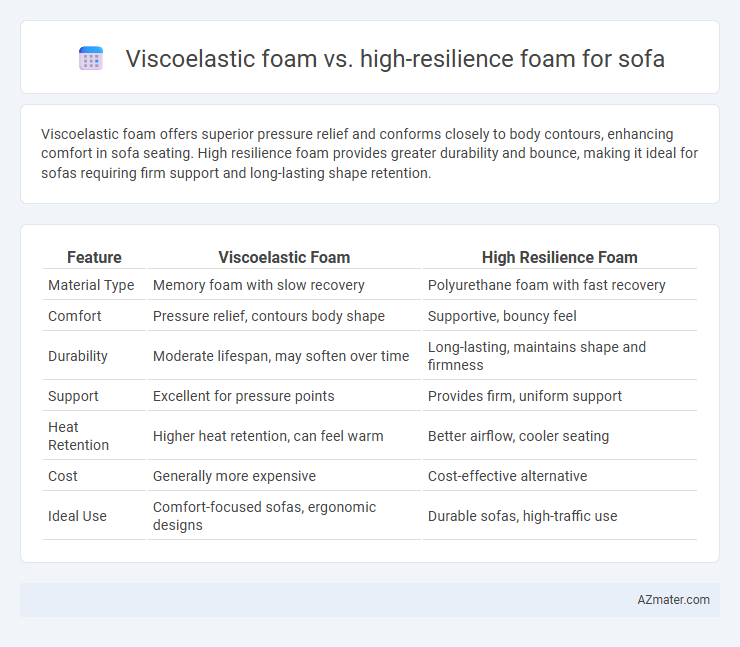Viscoelastic foam offers superior pressure relief and conforms closely to body contours, enhancing comfort in sofa seating. High resilience foam provides greater durability and bounce, making it ideal for sofas requiring firm support and long-lasting shape retention.
Table of Comparison
| Feature | Viscoelastic Foam | High Resilience Foam |
|---|---|---|
| Material Type | Memory foam with slow recovery | Polyurethane foam with fast recovery |
| Comfort | Pressure relief, contours body shape | Supportive, bouncy feel |
| Durability | Moderate lifespan, may soften over time | Long-lasting, maintains shape and firmness |
| Support | Excellent for pressure points | Provides firm, uniform support |
| Heat Retention | Higher heat retention, can feel warm | Better airflow, cooler seating |
| Cost | Generally more expensive | Cost-effective alternative |
| Ideal Use | Comfort-focused sofas, ergonomic designs | Durable sofas, high-traffic use |
Introduction to Sofa Foam Options
Viscoelastic foam, known for its pressure-relieving properties and slow response to weight, molds closely to the body for superior comfort in sofas. High resilience foam offers excellent durability and immediate support with its quick recovery rate, making it ideal for maintaining sofa shape over time. Choosing between these foams depends on whether comfort or long-term firmness is the priority.
What is Viscoelastic Foam?
Viscoelastic foam, commonly known as memory foam, is a type of polyurethane foam infused with additional chemicals to increase viscosity and density, offering superior body contouring and pressure relief for sofa cushions. This material responds to heat and pressure, allowing it to mold to the user's shape and provide optimal comfort and support while reducing motion transfer. In contrast to high resilience foam, which is more springy and provides faster recovery, viscoelastic foam excels in cushioning by adapting closely to body curves and maintaining durability over extended use.
What is High Resilience Foam?
High resilience foam is a type of polyurethane foam characterized by its superior durability, elasticity, and ability to quickly regain its shape after compression. This foam provides firm support and excellent breathability, making it ideal for sofa cushions that require long-lasting comfort and resilience. Compared to viscoelastic foam, high resilience foam offers better support and quicker recovery, enhancing the overall seating experience.
Comfort Comparison: Viscoelastic vs High Resilience Foam
Viscoelastic foam offers superior pressure relief and body contouring, making it ideal for personalized comfort and reducing pressure points on sofas. High resilience foam provides greater bounce and durability, ensuring long-term support and maintaining shape over time. Choosing between viscoelastic and high resilience foam depends on whether comfort prioritizes softness and adaptability or firm support and resilience.
Durability and Lifespan of Each Foam Type
Viscoelastic foam, known for its slow recovery and contouring properties, typically has a lifespan of 5 to 7 years under regular use, with durability affected by its density, usually ranging from 3 to 6 pounds per cubic foot. High resilience foam offers superior durability and a longer lifespan, often exceeding 7 to 10 years, due to its high bounce-back ability and resistance to compression, with densities commonly between 1.8 to 2.8 pounds per cubic foot. For sofa cushions, high resilience foam maintains shape and support better over time, making it the preferred choice for long-term durability compared to viscoelastic foam, which may degrade faster with frequent use.
Support and Pressure Relief Differences
Viscoelastic foam, commonly known as memory foam, offers superior pressure relief by conforming closely to the body's contours, distributing weight evenly and minimizing pressure points. High resilience foam provides stronger support with its faster response time and greater bounce, maintaining structural integrity under prolonged use. The primary difference lies in viscoelastic foam's enhanced cushioning effect versus high resilience foam's emphasis on durable, supportive comfort for sofas.
Price and Value Considerations
Viscoelastic foam, often known as memory foam, typically commands a higher price due to its superior pressure relief and contouring capabilities, offering exceptional comfort for sofa cushions. High resilience foam, while more affordable, provides greater durability and responsiveness, making it a cost-effective option for long-term use without sacrificing support. Balancing price and value, viscoelastic foam suits consumers prioritizing plush comfort, whereas high resilience foam delivers longevity and firmness at a lower investment.
Maintenance and Care Tips
Viscoelastic foam requires regular rotation and gentle cleaning to prevent permanent impressions and maintain its contouring properties, while avoiding exposure to direct sunlight to preserve the foam's viscoelasticity. High resilience foam benefits from more frequent vacuuming and occasional spot cleaning with mild detergents to sustain its supportive structure and resilience over time. Both foam types should be kept dry and aired out periodically to prevent mold growth and odor retention, enhancing the sofa's durability and comfort.
Best Uses: Which Foam for Which Sofa Style?
Viscoelastic foam, known for its pressure-relieving properties and slow recovery, is ideal for lounge-style sofas and recliners that prioritize comfort and contouring support. High resilience foam offers superior durability and bounce, making it the best choice for traditional and contemporary sofas that require firm support and maintain their shape over time. Choosing between viscoelastic and high resilience foam depends on the sofa's intended use, with viscoelastic favored for relaxation-focused pieces and high resilience optimal for everyday seating and structural integrity.
Conclusion: Choosing the Right Foam for Your Sofa
Viscoelastic foam offers superior pressure relief and conforms closely to body contours, ideal for those seeking maximum comfort and support in a sofa. High resilience foam provides greater durability and quicker responsiveness, making it perfect for sofas that require long-lasting shape retention and robust cushioning. Selecting the right foam depends on balancing comfort preferences with the sofa's intended usage and lifespan requirements.

Infographic: Viscoelastic foam vs High resilience foam for Sofa
 azmater.com
azmater.com